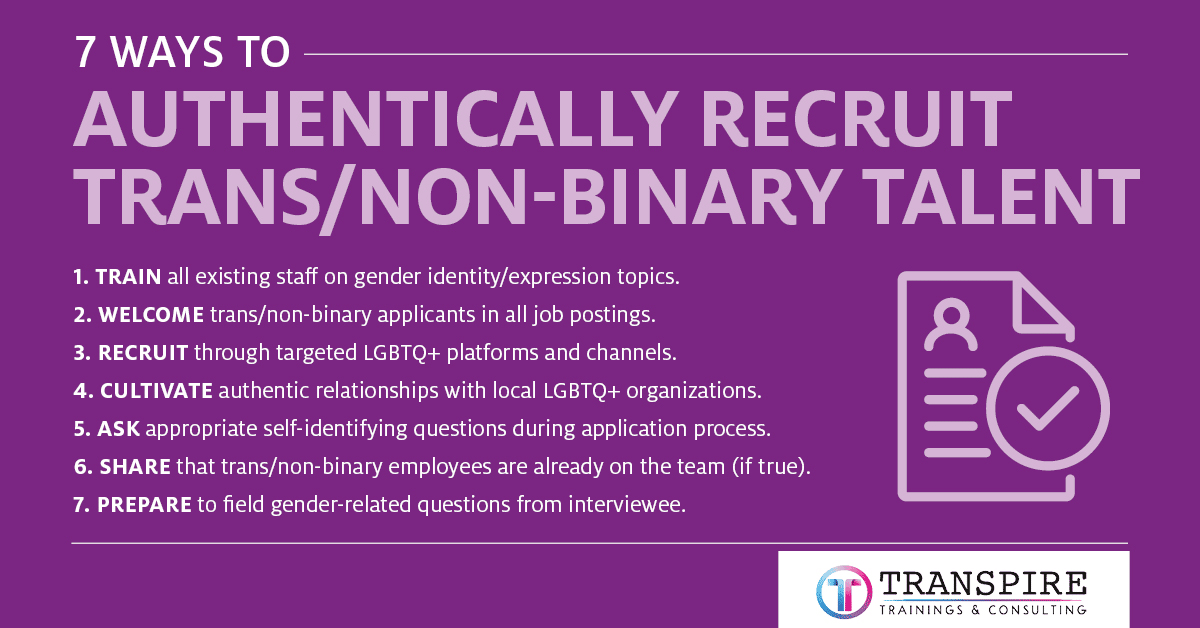Recruiting and retaining talent with a vast array of social identities is crucial for HR leaders looking to advance equity, diversity, and inclusion. Studies have repeatedly shown that diverse teams drive better business performance, and companies with more diversity become more innovative and resilient. While much progress has been made to advance diversity and inclusion in the workplace, gender identity is often and unfortunately overlooked.
Organizations can greatly benefit from the perspectives of transgender and non-binary employees, many of whom have lived experience and insights stemming from navigating a unique journey in a society that has struggled to embrace gender nonconformity.
Understanding Terminology for Supporting Transgender Employees
First, make sure you and organizational leaders understand the meaning of the following terms:
Gender identity is a person’s deeply felt, internal sense of their own gender. While many of us were raised within a rigidly binary gender construct (male / female), gender identities are vast and varied. There are myriad genders — especially when we look across cultures, subcultures, and around the world.
Gender expression is how people attempt to communicate their gender to the outside world through behavior, physical appearance, clothing and accessories, and mannerisms. It’s important to note that someone’s gender expression may not accurately reflect their gender identity (for a variety of reasons), and it’s a best practice to avoid making assumptions about gender identity based on gender expression.
Transgender is an umbrella term used to describe people who identify as any gender other than the one that they were assigned at birth. To identify as non-binary (often seen as being “under the trans umbrella”) means that a person’s gender identity doesn’t fall squarely within the binary construct of male vs. female. As is the case with most of the language we have for social identities, the term can mean different things for different non-binary identified people. Some identify as both a man and a woman. Others describe their gender as a unique blend of masculine and feminine traits. Some report feeling neither masculine nor feminine at all, while some experience their gender as being beyond the rigidity of binary gender norms. For others, it might mean something else entirely.
Why Supporting Transgender Employees Is Critical
Transgender and non-binary employees face a variety of issues in the workplace. Socially, they’re often subjected to microaggressions (indirect, subtle, sometimes unintentional discriminatory acts), as well as overt bias, bullying, and isolation. They may experience pushback from colleagues when requesting that their name and gender pronouns (he, she, they, etc.) be honored. They often run into challenges in the work environment’s gendered spaces, such as restrooms and locker rooms.
At an organizational level, HR policies don’t always outline practices for supporting transgender employees. For example, anti-discrimination policies often omit gender identity and expression as protected classes, and many employer-provided insurance policies don’t cover access to care for those who are seeking to medically transition.
For those who do transition on the job, navigating the workplace can be even more complex and difficult. Without overtly supportive policies and practices in place, and a culture that promotes inclusive leadership practices, trans or non-binary team members are likely to feel excluded and unsupported, become disengaged, or even resign.
Individuals of all social identities should be able to feel respected and supported at work, and transgender and non-binary people are no different.
7 Ways to Recruit Transgender and Non-Binary Talent
Tips for HR Leaders and Organizations
To benefit from the diverse backgrounds and lived experiences of trans and non-binary talent, your organization needs to authentically recruit from these communities. Trans people want to know that your organization will offer an affirming work environment in which they can bring their whole selves. Here are 7 of the many ways to authentically recruit and retain transgender/non-binary talent:
1. Train all staff on gender identity / expression topics.
It can be damaging for all parties to hire trans and non-binary people into an environment where there’s a risk that some colleagues may not be informed or supportive. At CCL, we’ve partnered with Transpire Trainings for this purpose and highly recommend their programs as a tool to educate and inspire your team. When your staff is knowledgeable on trans topics, it will be apparent to people you’re attempting to recruit from trans / non-binary communities.
2. Welcome trans / non-binary applicants in all job postings.
This could mean including a direct invitation or an anti-discrimination policy that clearly spells out gender identity / expression as being protected at your organization.
3. Recruit through targeted LGBTQ+ platforms and channels.
To ensure your job postings are reaching qualified trans and gender non-binary applicants, consider recruiting through targeted LGBTQ+ platforms, including online exchanges and message boards (“Queer Exchanges” on Facebook or other social platforms, local LGBTQ+ media outlets, etc.).
4. Cultivate authentic relationships with local LGBTQ+ organizations.
Another way to reach qualified trans / non-binary applicants is to form relationships with local LGBTQ+ organizations and community centers, who often meet with people in need of employment.
5. Ask appropriate self-identifying questions during the application process.
Within your application’s demographic questions, offer multiple gender identity choices as well as a write-in option to allow applicants to self-identify their gender (as opposed to limiting the options to the standard “male,” “female,” or “prefer not to answer”). Not only will this let prospects know that you understand and respect the broad spectrum of gender identities, but this data is also useful for your organization to understand the gender diversity of your applicants and team.
6. Share that trans / non-binary employees are already on the team (if true).
If the applicant openly discusses their gender identity during the interview process, share that there are already trans or non-binary people on the team (if this is true). The applicant may be testing the waters by bringing it up, and just hearing you say this signals that your team or organization is striving to be inclusive.
7. Prepare for gender-related questions from the interviewee.
All hiring managers and interview panels should be prepared to answer questions from candidates about gender diversity and transition-related HR practices. If you’ve invested in educating your team on gender identity and expression and are committed to supporting transgender employees, this part should be relatively easy.
Access Our Webinar!
Watch our webinar, How Aspects of Identity Can Affect the Way You Lead & Work With Others, to understand the relationship between social identity and bias, and how to shift your perspective to move past awareness to actions that help you and your organization cultivate equity, diversity, and inclusion.
How to Retain & Support Transgender and Non-Binary Employees
Build Psychological Safety for All Team Members
When people don’t feel a sense of psychological safety at work, they’re likely to leave for new opportunities — and your organization misses out on the richness of their talents and contributions. Once you’ve made the hire, ensure you retain trans and non-binary talent by implementing the following recommendations.
1. Establish inclusive and specific anti-discrimination policies.
If you’re serious about inclusion in the workplace, it’s important to specifically name gender identity / expression as protected classes in your organization’s anti-discrimination policy, as well as to outline specific practices such as allowing employees to use restroom facilities that correspond to their gender identity or gender expression. Just as with applicants, employees should be allowed to self-identify their gender in official records, and to use the name and pronouns they’re most comfortable with in the workplace (even when there is incongruence with legal documents).
2. Ensure transition-related care is adequately covered by your insurance policies.
It’s vital for organizations to provide medical insurance policies that specifically cover transition-related care. For trans people seeking to medically transition, it can be stifling and harmful to be hired into an organization with a trans-exclusionary insurance policy. There are many challenges that trans communities navigate when seeking gender-affirming care; access and affordability are at the top of the list.
3. Normalize gender-inclusive language and all pronouns.
Educating your team about normalizing gender-inclusive language (using “hello, everyone!” versus “hey guys!” or “hi ladies and gents!”), and the sharing and respecting of all gender pronouns, will go a long way toward supporting transgender employees. Train leaders in techniques to build belonging at work and encourage all employees to include gender pronouns on business cards and in official email signatures. Not only does this reduce the likelihood of misgendering staff internally, but it also communicates organizational comfort with gender diversity to employees, customers, and external partners.
4. Interrupt bullying and discrimination quickly, sensitively, and appropriately.
Supporting transgender employees and improving retention of trans / non-binary people includes taking seriously incidents involving microaggressions, bullying, or discrimination, and dealing with them quickly and sensitively (centering the needs of the trans / non-binary person). Learn more about leading with inclusion and belonging in the workplace.
5. Compensate transgender people fairly.
Much like people from other marginalized communities, trans / non-binary individuals have been historically underpaid and relegated to frontline (or back office) roles. Through an equity lens, it’s important to compensate your trans / non-binary staff fairly, to invest additional organizational resources into their development and success, and to create genuine opportunities for advancement, mobility, and visibility. Offering opportunities where they can use the breadth of their talent will maximize the value they bring to your organization. And because you asked all employees to self-identify their gender in official records (tip No. 1 from above), you’ll have accurate data to conduct pay audits.
Supporting Transgender Employees Through Allyship
As more organizations make a committed effort to take real action on DEI (diversity, equity, and inclusion), it’s important not to leave behind trans / non-binary communities, who experience incredible challenges with garnering and maintaining gainful employment. According to a study from The Conversation, individuals who described themselves as transgender were 11% less likely to be working compared to non-transgender, or cisgender, people.
Diverse gender identities aren’t new, but in many organizations, trans topics are still quite novel. And because gender identity and expression are so deeply personal, many leaders express apprehension around doing or saying “the wrong thing.”
However, shying away from these conversations only reinforces a culture of silence, stigma, and even transphobia, all of which are hurtful to trans and non-binary communities, and damaging to our collective efforts to support diversity and inclusion.
Perhaps most importantly, understanding how we can show allyship and supporting transgender employees means embracing an ongoing willingness to make mistakes, learn, and grow together.
Ready to Take the Next Step?
Diverse organizations are more resilient, innovative, and higher performing. Discover how our equity, diversity, and inclusion practice and solutions can help create sustainable changes in your organization, and explore more about supporting transgender employees by reaching out to Transpire Trainings.
We would like to thank Landon Woolston, Founder of Transpire Trainings, for their contributions to this article.










